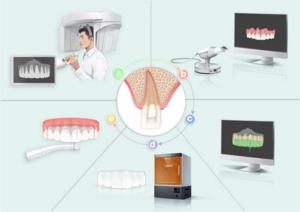A recent article introduces a transformative approach to endodontics called Digital Guided Therapy (DGT), poised to revolutionize dental treatments. This state-of-the-art method is distinguished by its superior accuracy, enhanced efficiency and significantly less invasive procedures. DGT sets a new benchmark in dental healthcare, offering a long-term solution that could redefine traditional practices and improve patient outcomes.
Endodontic diseases represent a significant challenge in dentistry due to their complex nature and the precision required in treatment. Traditionally, the success of these treatments has relied heavily on the skill and experience of the dentist. Digital Guided Therapy (DGT) is emerging as a transformative solution, leveraging cutting-edge technology to improve accuracy and treatment outcomes.
In a new review () was published in International Journal of Oral Science, experts from 13 universities in China reveal the potential of DGT in transforming endodontic treatments. This innovative approach promises increased precision, efficiency and minimal invasiveness, setting a new standard in dental care.
The study fundamentally changes the traditional root canal treatment landscape. By incorporating cutting-edge technologies such as advanced imaging, computer-aided design (CAD) and 3D printing, DGT facilitates the performance of highly precise and minimally invasive endodontic procedures. This research divides DGT into two main categories: Static Guided Endodontics (SGE) and Dynamic Guided Endodontics (DGE). SGE uses pre-designed drill guides, produced through 3D printing, to ensure precise access to the root canal without damaging the surrounding tissues. DGE, on the other hand, uses real-time navigation systems, providing live feedback to dentists during the procedure, thereby enhancing treatment accuracy. This dual approach significantly mitigates the risks associated with conventional methods, such as perforations or missed channels, by ensuring precise drill paths and processing areas. The successful application of DGT in complex cases, as highlighted by the research, shows its potential not only to improve clinical outcomes but also to reduce patient discomfort and recovery time.
Dr. Junqi Ling, the lead author, states, “Digital Guided Therapy not only marks a major advance in endodontics by offering personalized, precise treatment pathways, but also significantly reduces the risk associated with traditional procedures.”
The application of DGT extends beyond conventional treatments, providing a viable solution for historically difficult cases. Its precision and minimally invasive nature not only preserves tooth structure but also enhances patient recovery, setting a new benchmark for endodontic care.
###
bibliographical references
DOI
Original source URL
About International Journal of Oral Science
International Journal of Oral Science (ISSN 1674-2818) was established in 2009 and aims to publish all aspects of oral science and interdisciplinary fields, including basic, applied and clinical research. Areas covered include oral microbiology, oral and maxillofacial oncology, caries, oral inflammation and infection, dental stem cells and regenerative medicine, craniofacial surgery, dental materials, oral biomechanics, oral, dental and maxillofacial genetic and developmental diseases.
Denial of responsibility: AAAS and EurekAlert! are not responsible for the accuracy of news releases published on EurekAlert! with contributing institutions or to use any information through the EurekAlert system.

